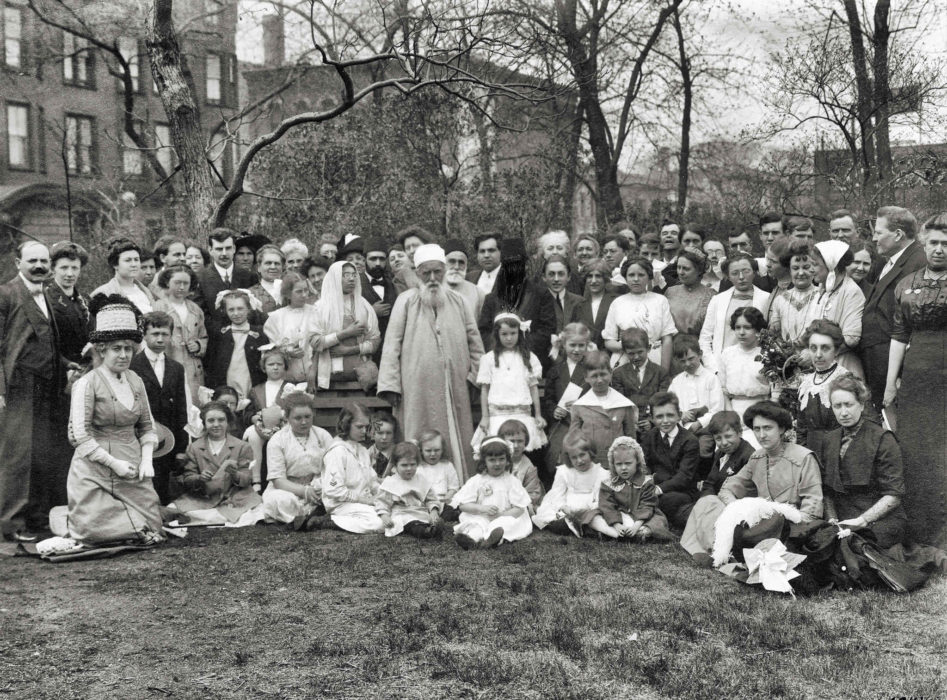‘ABDU’L-BAHÁ SPENT HIS last few days in New York in the neighborhood of Riverside Park on the Upper West Side. He took daily walks along the Hudson River, met the continuing stream of guests that arrived to see him almost every day, and had more intimate conversations with the Americans who were closest to him. These smaller gatherings served a special purpose for which he had also come to America.
It was one thing to speak in broad terms about principles, map out prescriptions for international peace, and carry on a rhetorical battle against the modern ideologies of race, gender, militarism, social darwinism, and religious and class prejudice. It was something else entirely to put into practice Bahá’u’lláh’s complete vision for constructing a new global civilization. That task would be long and hard, it would demand daily struggle, and it would require building a dedicated community of people who would commit themselves to that long-term goal. That’s why, in smaller groups, and usually toward the end of his stays in each city, ‘Abdu’l-Bahá focused special attention on the Americans around him who called themselves Bahá’ís.

In 1912, there were about 1,000 of them living in North America. Although a few were very wealthy, most of them came from the emerging middle-class; in some towns, such as Kenosha, Wisconsin, several members of the working class had become Bahá’ís. In New York, Bahá’ís often visited ‘Abdu’l-Bahá at the home of Edward and Carrie Kinney, who leased an elegant house that occupied two-thirds of a long and narrow lot on the southeast corner of West End Avenue and West 98th Street, one block east of Riverside Drive and eight blocks north from the home of Mrs. Emery, to whose house at 273 West 90th Street ‘Abdu’l-Bahá had moved for his final six nights. The Kinneys’ ground floor rooms opened to create a single large space that could seat 250 or 300 people.
The conversations ‘Abdu’l-Bahá had with groups of Bahá’ís also touched on two subjects that he did not usually address in his engagements with the public. He spoke to them about the absolute priority of maintaining unity in a religious community that had abolished any form of priesthood. Every religion of the past had split into factions when one leader’s interpretation of scripture conflicted with another’s. Bahá’u’lláh had dealt with the challenging issue of religious authority by establishing what he called his “Covenant.” Although individual Bahá’ís had to develop their own understanding of Bahá’u’lláh’s writings, they had no right to impose their own views on others. Instead, in his Will and Testament, Bahá’u’lláh had vested interpretive authority in just one person: his son ‘Abdu’l-Bahá. In place of nominating a special class of individuals to administer the community, Bahá’u’lláh had created elected bodies, which ‘Abdu’l-Bahá called “spiritual assemblies.” ‘Abdu’l-Bahá began to build this system of governance among the North American Bahá’ís.

‘Abdu’l-Bahá also challenged them to spread their new religion beyond their own borders. “Teachers must continually travel to all parts of the continent, nay, rather, to all parts of the world,” he wrote to them in the middle of the war, on April 19, 1916, “but they must travel like ‘Abdu’l-Bahá, who journeyed throughout the cities of America.” That is, they must bear the costs themselves — not accepting money from any source outside the voluntary contributions of their own membership — and they must distinguish themselves by their deeds.
In 1921, when ‘Abdu’l-Bahá passed away, his own Will and Testament gave instructions for the continuation of Bahá’u’lláh’s Covenant, and for electing governing bodies at the local, national, and international levels. North American Bahá’ís dispersed around the world to build them. Today Bahá’ís reside in more than 100,000 cities, towns, and villages around the world. More than 10,000 spiritual assemblies are elected every year, operating in over 200 countries.






